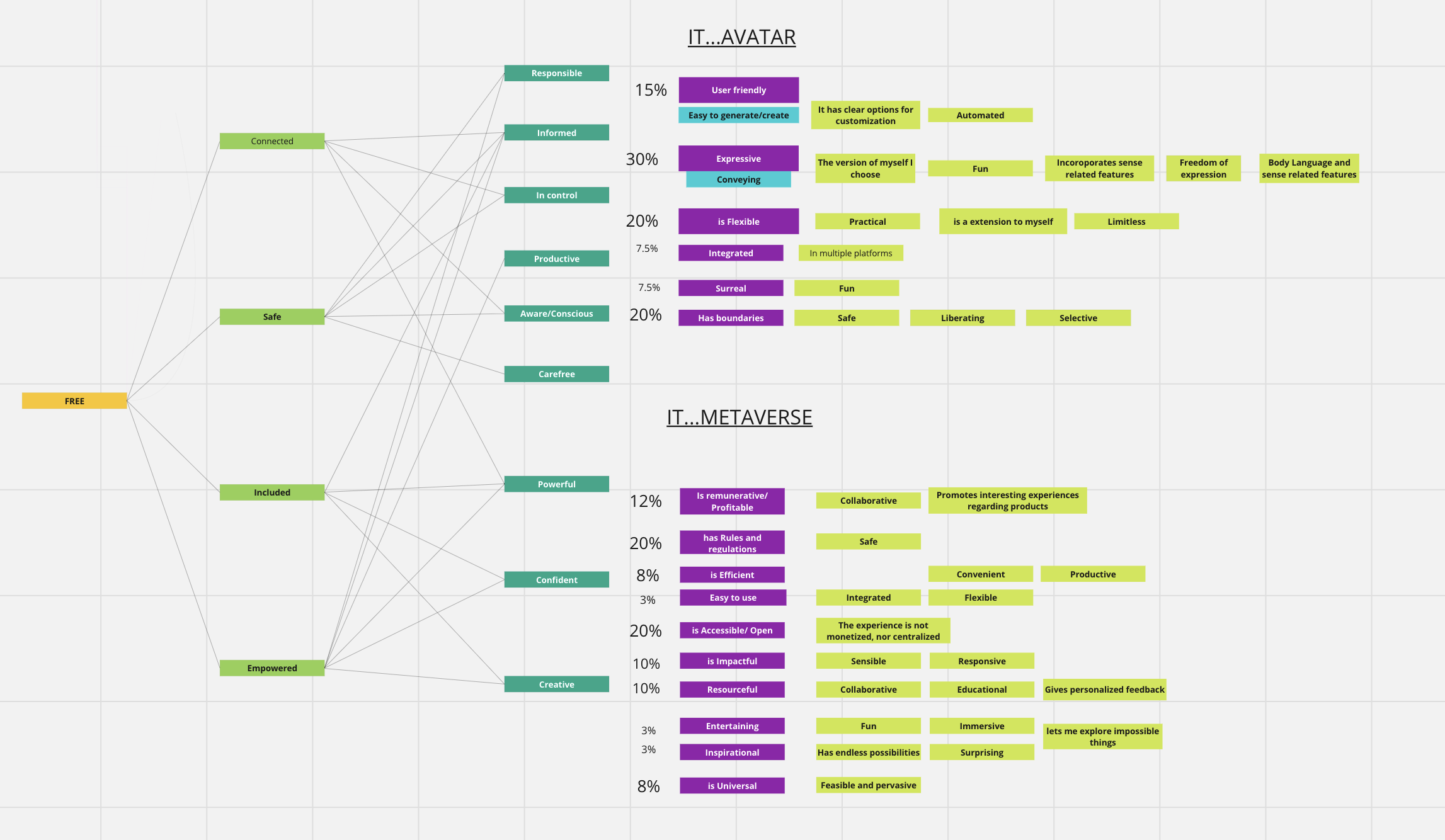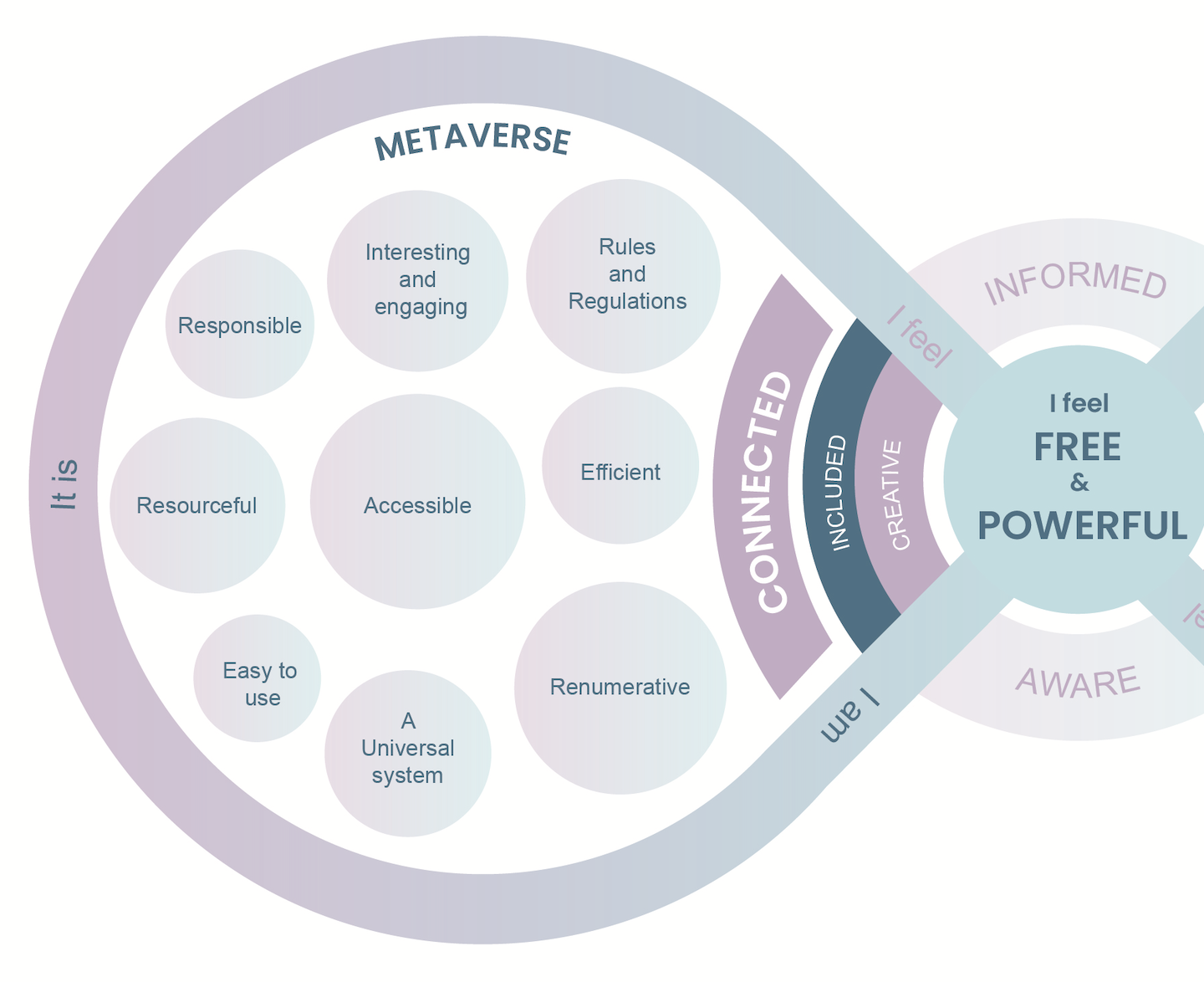Get in Touch
The Ideal Experience of Identities in the Metaverse

Ideal Experience Framework guided from Lextant Framework
Research Published by Lamina1 Company, alongside their Identity Lite Paper ︎
Research Published by Lamina1 Company, alongside their Identity Lite Paper ︎
Goal
With our lives becoming increasingly intertwined with the digital realm, the idea of Identity has expanded to virtual representations of our selves in the form of avatars. Our virtual identities or Avatars could be determined by various aspects of our psyches and our own unique perceptions of the world. Through this project, we dig deeper into the differences between real world and virtual identities and how it shapes social interactions in different environments.
The goal of this project was to explore and understand “the ideal experience of identities in the Metaverse” through a user-centered, contextual design research approach. Our aim was to gain insights into the needs, desires, and pain points of users in this new digital environment and to inform the design of Metaverse experiences that are inclusive, empowering, and reflect the diversity of identities through its Avatars.
The goal of this project was to explore and understand “the ideal experience of identities in the Metaverse” through a user-centered, contextual design research approach. Our aim was to gain insights into the needs, desires, and pain points of users in this new digital environment and to inform the design of Metaverse experiences that are inclusive, empowering, and reflect the diversity of identities through its Avatars.
Process
Our project spanned over 10 weeks, comprising an initial 7-week phase dedicated to in-depth quantitative and qualitative research, followed by a final 3-week phase for the comprehensive culmination and analysis of the gathered extensive data.
This project, we meticulously adhered to Lextant Methodology of UX Research. Our process began with close interactions, observations, and deep insights gathered from professionals spanning various roles within the metaverse community.
We conducted extensive primary research, employing a combination of :
- Cultural Probes
- Sensory Cues
- Contextual Interviews
- Observations
- Research Workshops
![]()
![]()
![]()
Research conducted at a famous spot of Savannah, outside Leopold’s ice cream parlour
This project, we meticulously adhered to Lextant Methodology of UX Research. Our process began with close interactions, observations, and deep insights gathered from professionals spanning various roles within the metaverse community.
We conducted extensive primary research, employing a combination of :
- Cultural Probes
- Sensory Cues
- Contextual Interviews
- Observations
- Research Workshops



Research conducted at a famous spot of Savannah, outside Leopold’s ice cream parlour
Industry Relevance
Validating the industry relevance and showcasing the increasing prominence of digital lives as a pivotal facet of our daily experiences.
“In January’22, Microsoft announced the largest acquisition in Big Tech history, paying $75 billion for gaming giant Activision Blizzard, which would provide building blocks for the metaverse.”
- Forbes“Consumers will increasingly spend as much on products for their Avatars as much as their physical selves.”
- WGSN
User Research
12 Interviews
60+ Probe Participants
1800+ Data Points
We conducted interviews with Twelve participants (4 Experts and 9 Metaverse users and enthusiasts) by recruiting strategically screened users and experts that fall into the Milennial age bracket. Our target user group included tech-savvy college students and early career professionals between the ages of 23-35 years.
- Demography - Different Nationalities
-
Ratio of Male and Female - 3 : 1
- Medium - Online video chat
Interview / Discussion Guide had questions ranging from :
- Current knowledge on Metaverse
- Thoughts on Real Vs Virtual worlds
- Current Experience of Metaverse
- Barriers (Mental as well as Digital)
Interviewee’s Remarks
“I think there is some sort of romanticism to having a digital counterpart that thinks like you, behaves like you”
“It would be nice to pick out these 'suits' (avatars) and not be attached to any”
“According to me, Metaverse is like a virtual world, it is basically living a second life”
Affinitization
Through affinitizing the findings from research workshops and qualitative methods, we found out that
![]()
![]()

![]()
![]()
40%
Respondents listed an entity with percieved high social status and POWER as the identity they would like to project if given the choice.60%
Respondents listed entities with supernatural abilities, objects and animals of their liking indicating that they would express themselves more FREELY if societal and other real world limitations did not apply.




Insight Translation
+
Pattern Recognition
We began discerning patterns by aggregating user preferences for their 'Ideal' experience. Our analysis, illustrated below, segregated data into two facets: emotions within the Metaverse and emotions tied to identity in the Metaverse.
Notably, the prevailing sentiment of 'Freedom' emerged as a shared core emotion in both realms. This correlation facilitated a systematic approach, allowing us to prioritize recurring sentiments and thoughts through quantitative analysis.
![]()
Notably, the prevailing sentiment of 'Freedom' emerged as a shared core emotion in both realms. This correlation facilitated a systematic approach, allowing us to prioritize recurring sentiments and thoughts through quantitative analysis.

Framework
 This section represents to emotions users seek to experience At the essence of any product, service, or system lie emotions. In this context, the core emotions identified are "Freedom" and "Powerful".
This section represents to emotions users seek to experience At the essence of any product, service, or system lie emotions. In this context, the core emotions identified are "Freedom" and "Powerful". This section differentiates between "I Am" (Benefits) and "It Is" (Features) to delineate the core emotional benefits users seek and the specific characteristics they desire in their ideal Metaverse experience.
This section differentiates between "I Am" (Benefits) and "It Is" (Features) to delineate the core emotional benefits users seek and the specific characteristics they desire in their ideal Metaverse experience. This section differentiates between "I Am" (Benefits) and "It Is" (Features) to delineate the core emotional benefits users seek and the specific characteristics they desire in their ideal Avatar (Identity) experience.
This section differentiates between "I Am" (Benefits) and "It Is" (Features) to delineate the core emotional benefits users seek and the specific characteristics they desire in their ideal Avatar (Identity) experience.
Client Magazine

Learnings
Engaging in this project was a significant milestone in my journey as a designer, specifically shaping my understanding of research methodology and reinforcing the critical importance of empathy in design. I learned that empathy isn't merely a buzzword but a powerful tool in understanding and addressing user needs.
This project illuminated how to approach data collection without inadvertently influencing participants' thoughts, highlighting the significance of mindful and neutral prompts to ensure unbiased insights. It underscored the necessity of actively listening and observing without imposing assumptions, enabling a more genuine and unfiltered understanding of users' perspectives and needs.
This experience profoundly impacted my design philosophy, emphasizing the value of empathy-driven research and the ethical gathering of user insights.
This project illuminated how to approach data collection without inadvertently influencing participants' thoughts, highlighting the significance of mindful and neutral prompts to ensure unbiased insights. It underscored the necessity of actively listening and observing without imposing assumptions, enabling a more genuine and unfiltered understanding of users' perspectives and needs.
This experience profoundly impacted my design philosophy, emphasizing the value of empathy-driven research and the ethical gathering of user insights.
Project Info
Master’s Project 2022
Methodology of UX Research
Prof. Kwela Hermanns
Master’s Project 2022
Methodology of UX Research
Prof. Kwela Hermanns
Team Members
Cristina Cordova
Disha Shah
Kanika Trivedi
Sneha Shetty
Cristina Cordova
Disha Shah
Kanika Trivedi
Sneha Shetty
My Role
Multifaceted Researcher
Framework Developer
Publication Advocate
Multifaceted Researcher
Framework Developer
Publication Advocate
Influence and Outcomes
Research Findings were published in collaboration with Lamina1, a prominent LA-based blockchain company.
Also, submitted for presentation at the prestigious Open Metaverse Conference 2024.
Research Findings were published in collaboration with Lamina1, a prominent LA-based blockchain company.
Also, submitted for presentation at the prestigious Open Metaverse Conference 2024.